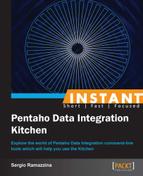Designing a simple PDI transformation (Simple) shows you how to design the simple transformation used as an example throughout all the recipes in this book. It also summarizes how we can develop a simple transformation using the design tool Spoon and some advises to follow in the development of transformations.
Designing a simple PDI job (Simple) shows you how to design a simple job that uses the transformation developed in the previous recipe. This job will be used as an example throughout all the book recipes. Like the previous recipe, it helps summarize how we can develop a simple job using the design tool Spoon and some advises to follow in the development of jobs and transformations.
Configuring command-line tools to run properly (Simple) represents the main starting point for everything. You will find what the main things are that you need to do to configure your PDI ETL system properly so that anything is able to work without any inconvenience.
Executing PDI jobs from a filesystem (Simple) is the first of a set of three recipes about how to start an ETL job from the command line. This is about how to start your PDI process when it is saved to the regular filesystem.
Executing PDI jobs packaged in archive files (Intermediate) explains the same topic as the previous recipe, but considers the process files to be packaged as an archive file. This is useful any time you use an ETL procedure on multiple systems (I mean for examples where you want to do some maintenance procedure) and you want to quickly move and run it without pain.
Executing PDI jobs from the repository (Simple) is the last in the series about how to start a job or transformation from the command line. This recipe is all about starting a job or transformation were the ETL files are stored in the repository.
Dealing with the execution log (Simple) explains how to efficiently use the various types of arguments available to manage the logfile and how to set the appropriate severity depending on the situation.
Discovering your PDI repository from the command line (Simple) is useful any time you decide to explore your PDI repository from the command line. It could so happen that you may forget what you have in your repository and where you have placed it. If that is the case, this is the recipe for you.
Exporting jobs and transformations to .zip files (Simple) shows you how to use a very simple and useful export mechanism. It could be useful to create a backup of your process files or to export them and easily move them to other systems.
Managing return code of PDI processes (Simple) is really the recipe for you if you need to get the procedure's return code to manage the conditional execution of other external processes.
Scheduling PDI jobs and transformations (Intermediate) tries to clear any doubts you have about scheduling your ETL processes.
